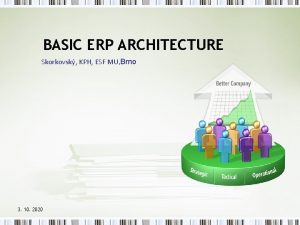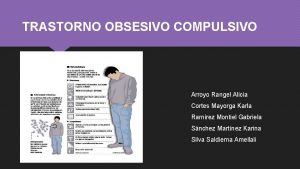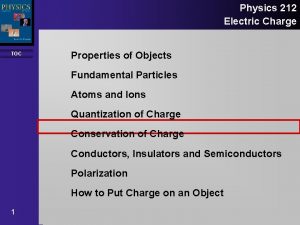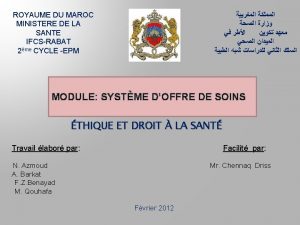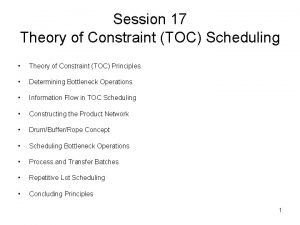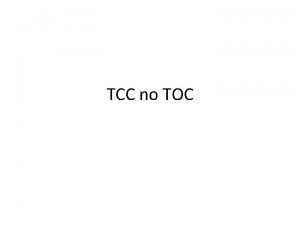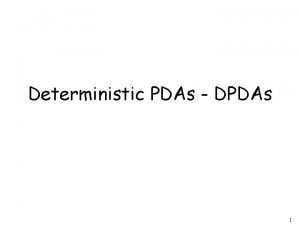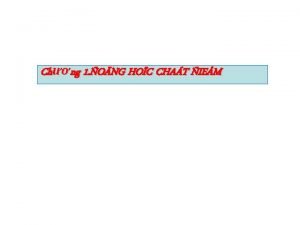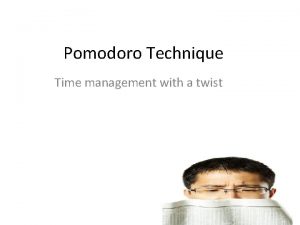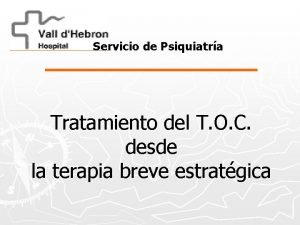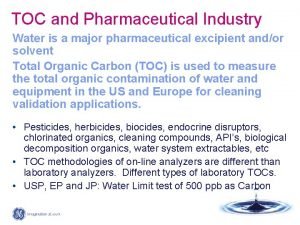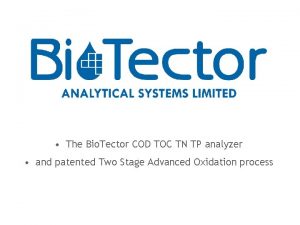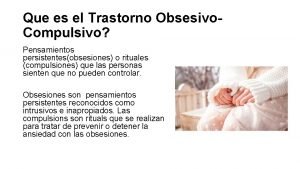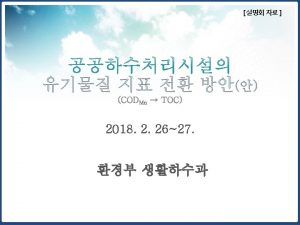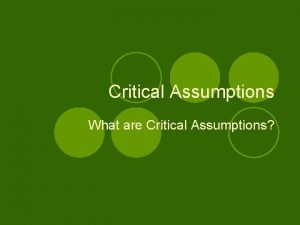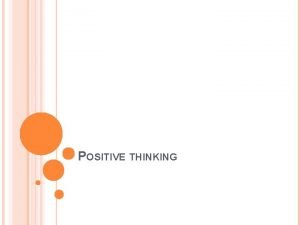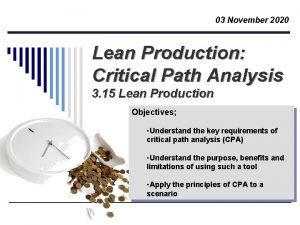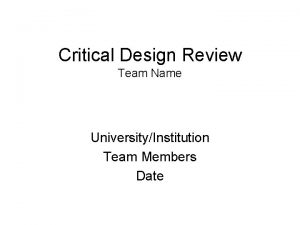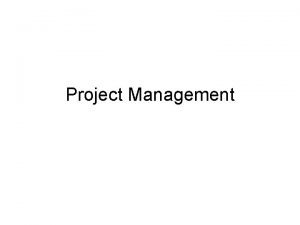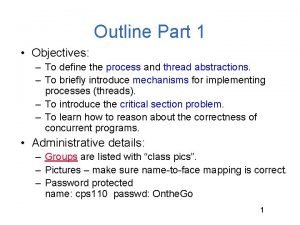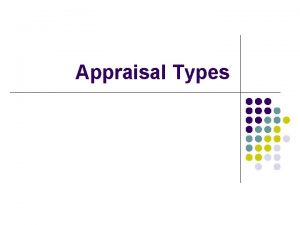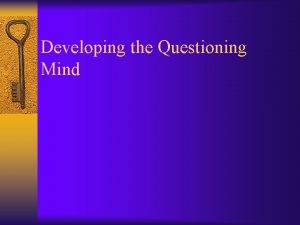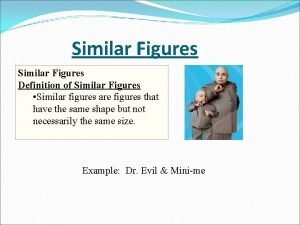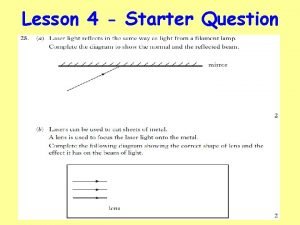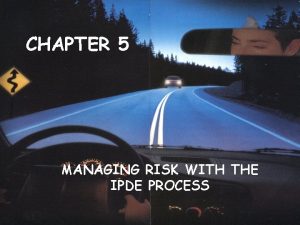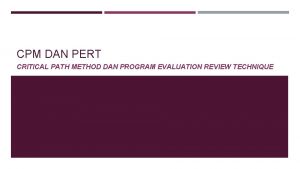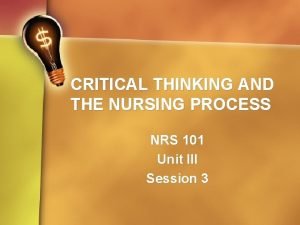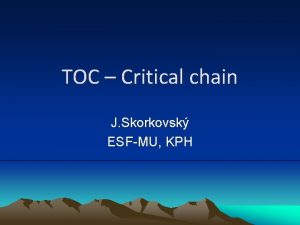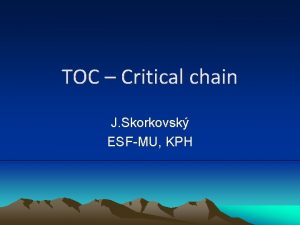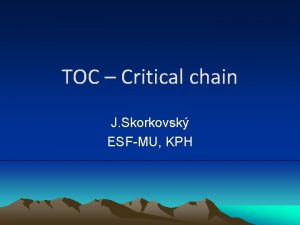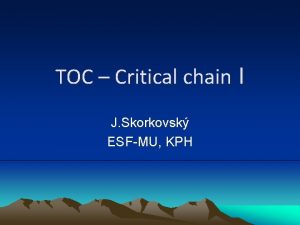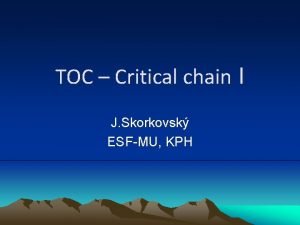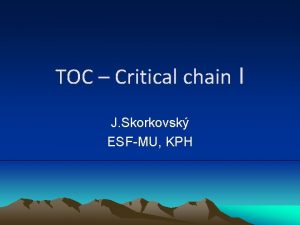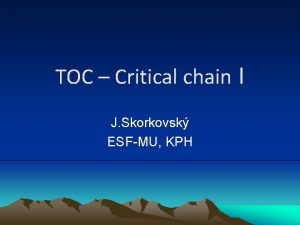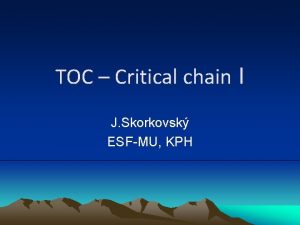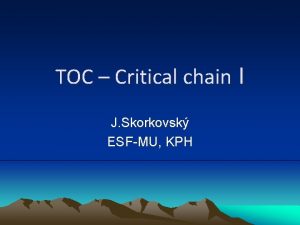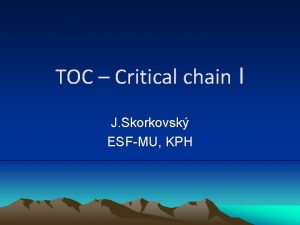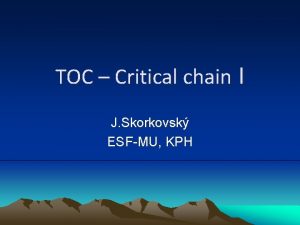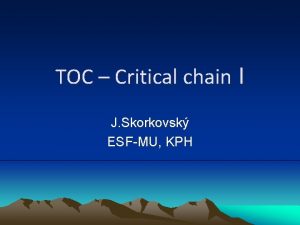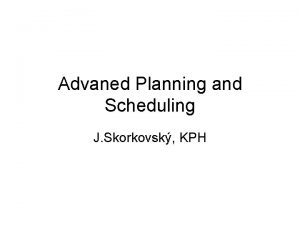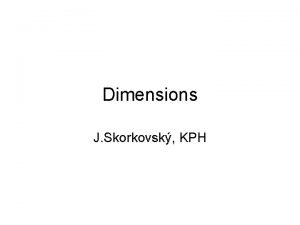TOC Critical chain J Skorkovsk ESFMU KPH TOC

































































- Slides: 65

TOC – Critical chain J. Skorkovský ESF-MU, KPH

TOC concisely I (see PWP presentation about TOC) • origin: E. M. Goldratt, Jerusalem • cost world<->throughput world • analogy weight of the chain – solidity of the chain • how to find a bottleneck? • tools of TOC – tree structures • CRT – EC – TT – PT – FRT meaning: • Current Reality Tree - Evaporating Cloud Tree– Transition Tree - - Prerequisite Tree – Future Reality Tree

TOC concisely I (see PWP presentation about TOC) • bottleneck in the project management is a critical path • finding (assessment) of bottleneck is not easy and often it is not explicit (uncompromising) • everybody knows something about TOC and nobody knows how to implement it to the real world- and this is again another bottleneck (tendon of Achilles from the heel to the scruff)

TOC-five steps (revision) Five steps process: Step 0. Identify the Goal of the System/Organization Step 0. 5 Establish a way to measure progress to Goal • • • Step 1. Identify the system’s constraint. Step 2. Exploit the system’s constraint. Step 3. Subordinate everything else to the above decision. Step 4. Elevate the system’s constraint. Step 5. If a constraint is broken (that is, relieved or improved), go back to Step 1. But don’t allow inertia to become a constraint.

Linear image of the project • activities – abscissas – Gantt graph • constantly changing conditions (Parkinson low, Murphy low, Student syndrome, customer changes - „fancies “, “caprices“. . …. ), Trouble

Parallel image of the project

Planner. One Scheduler

Planner. One Resource Planner

Project and its budget • • price of the whole project length (time) project stages and length of each activity assigned resources to every activity and their capacities (time per defined period) • time reserves (buffers) and their estimation • unfavourable influences (see Murphy´s lows http: //murphy. euweb. cz, etc. ) • additional activities (unexpected costs)

Selected Murphy´s laws • If your attack is going well, you have walked into an ambush (trap) • Planner is alerted about modification of the plan exactly in the moment, when the plan is finally adjusted • To carry out n+1 trivialities you need two times more time than time necessary to carry out n trivialities (law 99 %) • If anything can go wrong, it will • Any given program, when running, is obsolete • No matter how many resources you have, it is never enough • Brains x Beauty x Availability = Constant. This constant is always zero.

Resources and orders Matrix structure of multi-project environment – responsibility of project managers and responsibility of department managers are in conflict Chief 1 Chief 2 Resource D Order 1 Resource C Project manager 2 Resource B Order 2 Resource A Project manager 1 Resource E capacity overload time

Partial time of any activity in the project Variability of the real time assigned to activity Probability– median an element of statistical file, which is after sorting in the middle. Median of the set (1, 5, 2, 2, 1) is 2 100 „ 5 -miniutes meeting happened. How many times it took 5 minutes only ? Colleague ask for a quick rendez-vous: „Do not worry, it will take maximum 5 minutes!“. How long it takes on average? 5 min 15 min 45 min

Project environment is very complicated because of integration linkages and their dependencies A B -2 Probability of finishing tasks A to E in time is 50%. (50*50*…. *50=3, 125 %) 50% -5 What is a probability, that task F will start in time ? 50% +10 C D E -1 50% -7 50% +10 50% F 3% How the timely finishing of the tasks A, B, C and D will influence the integration point ? a) saving are fully wasted b) delay in one task will be immediately transferred to the next project task (activity) see +10

Project environment is very complicated because of integration linkages and their dependencies G B B G G B In order to start B in the upper branch, you have to finish G and also B in the lower branch. The probability, that B start in time is 50 % worse, than it was shown on the previous slide.

The project must be protected against influences of breakdowns (troubles) Standard estimation with protecting buffers for every activity 1 B B activity 2 B activity 3 = buffer activity 1 activity 2 activity 3 buffer 1 st step : every activity is shorten to 50 % of its original time size. 2 nd step : critical path buffer at the end of the project will have size of 50 % of the total sum of saved time created by shortening all partial activities B

Simplified scenario CPM and CCPM Task 1 Implicit Buffer 1 Task 2 Explicit Buffer Implicit Buffer 2 Saved time

EC and project management

Critical path, adjoining branches of the project and adjoining buffers (AB) activity 1 activity 2 activity 3 Critical path activity X activity Y AB Adjoining project branch Buffer serves as a safety tool to accumulate reasons of expected and unexpected delays Project buffer

Critical Path (CP) • Critical path is defined as the longest way (meaning time) from the starting point of the project graph to the ending point. • Every project has at least one critical path The rules of CP: • Every delayed task on CP will essentially delay the whole project • Truncation of duration of any task on CP will shorten whole project

Critical Path (CP) • Critical Path Method, abbreviated CPM, or Critical Path Analysis, is a mathematically based algorithm for scheduling a set of project activities. It is an important tool for effective project management.

Critical Path (CP) Milestones Activity

Critical Path (CP) Building a diagram 1

Critical Path (CP) Building a diagram 2

Critical Path (CP) Building a diagram 3

Critical Path (CP) Building a diagram 4 – calculating the FORWARD PASS ES EF 16=7+6+3 13 -7=6 Early Starts and Early finishes dates are calculated by means of Forward Pass

Critical Path (CP) Building a diagram 5 – calculating the BACKWARD PASS 13 -3=10 Slack Planüberhang, Slip, Scivolo, Regresso, Загрузочный περίοδοι απραξίας LS LF 10 -3=7 18 -2=16 Difference Forward-Backward : 16 -3=13 you can start 16 -3=13 7 minutes later and the time of the project (duration) is the same 13 -2=11 Late Starts and Late Finishes dates are calculated by means of Backward Pass

Critical Path (CP) Slack Building a diagram 6 – calculating the FLOAT(SLACK)/CP Free Float: Amount of time a single task can be delayed without delaying the early start of any successor task =LS-ES or LF-EF

Critical Path (CP) CPM is helpful in : • Project Planning and control. • Time-cost trade-offs. • Cost-benefit analysis. • Reducing risk.

Critical Path (CP) Limitation of CPM : • Does not consider resource capacities. • Less efficient use of buffer time. • Less focus on non critical tasks that can cause risk. • Based on only deterministic task duration. • Critical Path can change during execution.

Multi-project Management w 1 w 2 w 3 w 4 w 5 w 6 w 7 w 8 w 9 w 10 w 11 w 12 w 13 w 14 DAP Project 1 12 Project 2 12 Project 3 12 Bad multitasking causes, that one project will be significantly longer and no other project will be shorter K 1 K 2 K 3 w 1 w 2 w 3 w 4 w 5 w 6 w 7 w 8 w 9 w 10 w 11 w 12 36 DAP Project 1 6 Project 2 6 Project 3 6 18

Multitasking characterization • people always overestimate the length of their tasks • salesman offers impracticable terms (dates) • The fight for reserves (capacities) causes, that all saved time is fully wasted (Student´s syndrome) • Reserves (if any) are used badly !!!!!! • Bad use of reserves causes lack of transparent assignment • Non transparent priorities are parents of bad multitasking • Bad multitasking causes longer duration of all activities (tasks) and thus all the projects

CP definition (more in detail) Critical path is defined as the longest way (meaning time) from the starting point of the project graph to the ending point Critical path represents technological dependencies and given times of every task on Critical path inclusive of necessary condition for fulfilment of foregoing tasks (activities) framed by integration points.

Critical chain Task Resource

Contemplation I. Computing power Result ->Stress

Contemplation II. E-mails Parallel telephoning Parallel problem solving a) Am I a multitasker ? b) NO !! An my IQ went down 15 point due to parrel processing !

Contemplation III. Is this the goal of my lifelong efforts? Maybe not …. I guess I reached another peak¨…

Critical chain definition In TOC the Critical chain is defined as the longest way (meaning time) from the starting point of the project graph (Gantt) to the ending point which takes into account technological dependencies as well as time of the tasks and moreover, capacities of assigned resources. With infinite capacities of resources you can consider Critical path=Critical chain

Multi-project management and critical resources (CCR) used in more that one project branch X AB X Project buffer X AB Disadvantageous variant Critical chain CCR = Capacity Constrained Resource = X Critical path

Multi-project management and critical resources (CCR) used in more that one project branch AB X Project buffer X AB X After transformation of activities Critical chain

Project management based on remainimg time in buffers – Buffer Management • Buffers are used for timely warning and that is to say predicting and avoiding future problems related to project deadlines (milestones) • It is also used as a guideline for corrective actions

Basic metrics showing the project status • The partial size of Critical chain (CC) fulfilled in days (in %) • How much of buffer size was used to fulfil above mentioned partial size of CC ? • Trend of project (buffer consumption graph- see next slide) • Consumption of the financial buffer • Priorities – bigger buffer penetration- bigger priority • Adjoining branches have always lower priorities • It is not allowed to create bad multitasking

Trends of the project % use of the buffer Dangerous zone Warning zone Safety zone % consumption of the critical chain

Trend of the project advancement – (another angle of view) 100 % Buffer Penetraction Action plan OK 0% 100 % Time remaining till the end of the project 0 % Resource: DP R. Jurka (2006); taken from LEACH, L. , P. (2004), s. 12.

Planning - principles Today We are working with plan , which takes into account different times of tasks : - start of the tasks are changed based on termination of preceding tasks - you have to react in project in such a way , that handover is done as a baton pass during races 100% Planned start 2 D 1 Buffer penetration 4 days A 1 C 1 B 4 6 8 10 12 0 Plan with sharp deadlines with buffers 50% (2+3+3=8 8+4=12) 100% Critical chain completion 8 days Resource MPM systems

Planning - principles Today A 1 did not started yet , because this A 1 resource is still working on another order (task), which may be part of another project B 1 already started an for completion will need another two days 100% 1 C 1 D 1 Buffer penetration 4 days A 1 B 1 r 2 4 6 8 10 Planned start Plan with sharp deadlines with buffers 50% (2+3+3=8 8+4=12) 12 0 100% Critical chain completion 8 days Resource MPM systems

Plan 2 nd day after start Today A 1 started and will be finished (completed) tomorrow. B 1 will be finished (completed) tomorrow C 1 D 1 Buffer penetration 4 days A 1 B 1 r 100% 2 4 6 8 10 Planned start Plan with sharp deadlines with buffers 50% (2+3+3=8 8+4=12) 12 0 100% Critical chain completion 8 days Resource MPM systems

Plan 3 rd day after start Today A 1 despite all efforts resource A 1 needs another day to complete. B 1 has completed his work with 2 days delay 100% Planned start C 1 D 1 Buffer penetration 4 days A 1 B 1 r 2 3 4 6 8 10 12 0 Plan with sharp deadlines with buffers 50% (2+3+3=8 8+4=12) 100% Critical chain completion 8 days Resource MPM systems

Plan 6 day after start Today A 1 completed his task with 2 days delay B 1 completed his task with 2 days delay C 1 completed his task 1 day earlier than expected (planned) D 1 will start to work tomorrow Planned start C 1 D 1 Buffer penetration 4 days A 1 B 1 r 100% 2 4 6 8 10 12 0 Plan with sharp deadlines with buffers 50% (2+3+3=8 8+4=12) 100% Critical chain completion 8 days

Plan 8 day after start Today A 1 completed his task with 2 days delay B 1 completed his task with 2 days delay C 1 completed his task 1 day earlier than expected (planned) D 1 needs one day more to complete Planned start C 1 D 1 Buffer penetration 4 days A 1 B 1 r 100% 2 4 6 8 10 12 0 Plan with sharp deadlines with buffers 50% (2+3+3=8 8+4=12) 100% Critical chain completion 8 days

Plan 11 day after start Today A 1 completed his task with 2 days delay B 1 completed his task with 2 days delay C 1 completed his task 1 day earlier than expected (planned) D 1 completed his task with 2 days delay Planned start C 1 D 1 rezerva Buffer penetration 4 days A 1 B 1 r 100% 2 4 6 8 10 11 12 0 Plan with sharp deadlines with buffers 50% (2+3+3=8 8+4=12) 100% Critical chain completion 8 days

Clear way to setup and control priorities. Setup of priorities of partial tasks based on assigned reserves. Do as good as you can, but only where it is needed reserves

Project Quick, resources A-E and activities X, Z, X, W, and V Resource and activity Median of the required time Activity=Task 10 days A-Y You can say, that 50 % of any activities finish earlier, and other 50 % will be delayed, meaning, that 10 days represents 50 % of the estimated time for chosen activity Project managers decided, that activity ends if 90 % of estimated time will be consumed. It means, that they add a time buffer of 8 days (for the safety reasons). 10 d= 50%, 20 d=100%, 2 d=10%, 20 d-2 d=18 d, 18 d-10 d=8 d A-Y B-Z C-X D-W E-V 5 x 10 days=50 days

Time distribution Frequency 10 days 18 days Time

Five activities (tasks) and applied modifications • If we consider for every activity time buffer 8 days we will get : A-Y B-Z C-X D-W E-V 5 x 10 days= 50 days A-Y 8 B-Z 5 x 18 days= 90 days 8 C-X 8 D-W 8 E-V 8

Five activities and modifications (added buffers) and four types of troubles A-Y 8 A-Y Delayed „reporting“ B-Z Parkinson 8 C-X 8 D-W C-X We wait for resource D (even if C finished earlier) 8 E-V D-W 8 E-V Real delay No one trouble causes project delay taking into consideration planned delivery date (agreed date of the project). Dissipation of acquired time reserves was caused by company strategy saying strictly stick to the planned project schedule (example of rigid management)

Five projects after modification (buffers united to one and placed to the end of the project) A-Y B-Z A-Y C-X B-Z C-X Parkinson Earlier end of activity A 8 8 8 4 8 D-W E-V 8 D-W 8 8 E-V Little bit longer than 20 days median but shorter than 18 days 8 = CPB=current project buffer = 40 days = new buffer = 50 % out of CPB, which makes CPB/2

Critical path- Critical chain Activity V 14 days, resource A Activity W 6 days, resource B Critical path Activity Z 4 days, resource D START Activity X 6 days, resource C Activity Y 10 days, resource A END Critical Chain Project is considered as successful if is finished in expected time and financial budget is not exceeded

Critical chain with buffers Length of the Critical Chain (white line): 7+5+2+7=21 and originally it was all in all 28 days Activity V 7 days=14/2, RES A Activity W 3=6/2 days, RES B Adjoining buffer 1, 5 days Activity Z 2=4/2 days, RES D START Activity X 3=6/2 days, RES C Adjoining buffer 1, 5 days Activity Y 5=10/2 days, RES A Project buffer 7 days 7=(7+5+2)/2 END

Buffer consumption Activity A(10) Activity B(10) Project Buffer (10) 10=(10+10)/2 Activity A(5+8) Activity B(10) Project Buffer (10) Buffer penetration = 3 days Rate of penetration is used to assign priorities to the partial activities

PB-Project Buffer Priorities assigned to resources • If one resource have to be assigned to two activities starting in the same moment so the first activity which will start is the one belonging to the project with bigger project buffer penetration • If none of all project buffers were penetrated with previous activities, so the first starts this activity which belongs to the critical chain. A 1 Project Buffer 1 AB 1 Project Buffer 2 AB-Adjoining Buffer A 2 starts first because PB 2 is partially consumed (penetrated)

PB-Project Buffer AB-Adjoining Buffer Priorities assigned to resources DFB 3 Critical chain A 2 AB 2 Project Buffer 1 AB 1 Project Buffer 2 AB 3 This activity starts first because it is a part of the Critical chain and Project Buffer 1 is penetrated

Main benefits of the Critical Chain (CC) usage • Every single project ends significantly earlier, than projects where other project management methods than CC were applied • Total time needed to end more project than one is markedly shorter • Promised delivery times are fulfilled with higher rate of credibility • You will have more free capacity of all used resources

Main benefits of the Critical Chain (CC) usage • Better initial estimation about project timing and thus bore accurate planning • During starting of the projects you did not meet any problem taking into consideration drum resource • Decrease of unfavourable effects such as Student syndrome, Murphy attacks and impacts of Parkinson´s laws by redeployment and integration of all buffers to one and only one project buffer at the end of the project • Utilization of benefits caused by earlier ended activities • Use of reporting system which provides you with valuable information of buffer penetration , the extent of time reserves and thus better helping system for assigning priorities


Thanks for Your Attention
 Clochette saint nicolas
Clochette saint nicolas Debout jeunesse leve toi lyrics
Debout jeunesse leve toi lyrics Principle of sterilization
Principle of sterilization Critical semi critical and non critical instruments
Critical semi critical and non critical instruments 119-200 kph
119-200 kph Kph architects
Kph architects Ishikawa nedir
Ishikawa nedir Food chain sequence
Food chain sequence Critical reading meaning
Critical reading meaning Closed chain kinematics
Closed chain kinematics What is logistics management
What is logistics management Toc homosexual
Toc homosexual Toc mérés
Toc mérés Paper toc
Paper toc Vua nào thần tốc quân hành mùa xuân
Vua nào thần tốc quân hành mùa xuân Toc properties
Toc properties Tic toc yolanda crespo
Tic toc yolanda crespo Toc doc maroc
Toc doc maroc Lerivon effets secondaires
Lerivon effets secondaires Toc scheduling
Toc scheduling Mailchimp toc
Mailchimp toc Toc sintomas graves
Toc sintomas graves Toc pump module
Toc pump module Pda vs dpda
Pda vs dpda Toc for education
Toc for education Transition graph in toc
Transition graph in toc Vận tốc góc
Vận tốc góc Tic toc technique
Tic toc technique Sistema perceptivo reactivo
Sistema perceptivo reactivo Demi garcon
Demi garcon Chủng tộc
Chủng tộc Toc in pharmaceutical industry
Toc in pharmaceutical industry Biotector analytical systems ltd
Biotector analytical systems ltd Analizator toc
Analizator toc Toc enfermedad
Toc enfermedad Codtoc
Codtoc Toc 계산
Toc 계산 Toc doc maroc
Toc doc maroc Critical assumptions
Critical assumptions Critical thinking positive and negative
Critical thinking positive and negative Slideshare
Slideshare Creative thinking wiki
Creative thinking wiki Sat critical reading score
Sat critical reading score Critical path
Critical path Critical design review template
Critical design review template Literary theory
Literary theory Critical race theory
Critical race theory Critical path in project management example
Critical path in project management example Critical section
Critical section Local minimum
Local minimum Critical incident essays
Critical incident essays Outline critical approaches to interpreting text
Outline critical approaches to interpreting text The critical mind is a questioning mind
The critical mind is a questioning mind Critical thinking images
Critical thinking images Similar figures definition
Similar figures definition One-tailed vs two-tailed
One-tailed vs two-tailed Critical reading definition
Critical reading definition Differentiate inferential listening from critical listening
Differentiate inferential listening from critical listening Hse critical activities
Hse critical activities Critical angle
Critical angle Schaffer and emerson monotropy
Schaffer and emerson monotropy Ipde steps
Ipde steps When to reject null hypothesis critical value
When to reject null hypothesis critical value Contoh soal pert dan penyelesaiannya
Contoh soal pert dan penyelesaiannya Critical mass (sociodynamics)
Critical mass (sociodynamics) Steps of the critical thinking process
Steps of the critical thinking process





